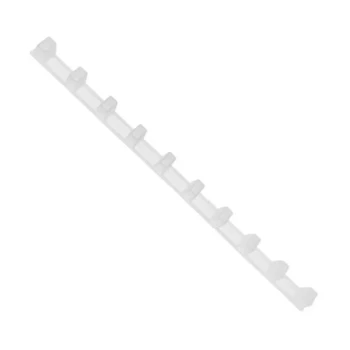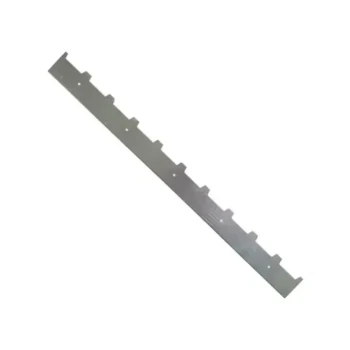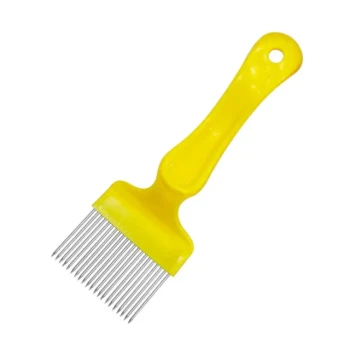The short answer is: Compressing frames together in the center of a hive box is a fundamental technique to maintain proper "bee space." This prevents bees from building irregular and problematic honeycomb, ensuring the hive remains manageable for inspections and promoting its overall health.
Managing a beehive is not about controlling the bees, but about creating a predictable environment that works with their natural instincts. Proper frame spacing is the most critical element of that environment, turning a chaotic natural structure into an orderly, inspectable colony.

The Guiding Principle: Understanding "Bee Space"
To grasp the importance of frame compression, you first need to understand the concept that governs modern beekeeping: bee space.
What Exactly is Bee Space?
Bee space is the specific gap size, ranging from 1/4 to 3/8 of an inch (6-9 mm), that bees naturally leave open as a passageway.
Any space smaller than this they will seal with propolis (a resinous glue). Any space larger than this they will fill with comb.
Why This Measurement is Everything
The modern Langstroth beehive is engineered entirely around this principle. The precise spacing between frames, and between the frames and the hive walls, is designed to be perfect bee space.
This encourages bees to build straight, even comb only within the provided frames, leaving the surrounding gaps open for movement.
The Problem with Gaps
When you reassemble a hive box after an inspection, frames can be pushed apart, creating gaps larger than the standard bee space. Bees instinctively view these larger gaps as an invitation to build comb where it doesn't belong.
The Consequences of Improper Spacing
Failing to compress and center your frames creates a cascade of problems that make managing the hive progressively more difficult and disruptive.
Creation of Burr and Brace Comb
Bees will quickly build burr comb or brace comb to bridge any gaps larger than 3/8 of an inch. This excess comb connects frames to each other, to the hive walls, or to the box above or below.
Difficult and Destructive Inspections
This unwanted comb acts like cement, locking the frames in place. Trying to remove a frame can require significant force, often resulting in:
- Rolling or crushing bees, including a high risk of killing the queen.
- Breaking the comb, causing honey to leak and creating a defensive reaction from the colony.
- Disrupting brood cells, killing larvae and stressing the hive.
Increased Risk of Pests
Broken comb and spilled honey can attract pests like wax moths and small hive beetles. The irregular comb structures also create hiding places for these pests, making it harder for the bees' natural hygienic behaviors to control them.
The Correct Technique: Compress and Center
The solution is a simple but non-negotiable step at the end of every inspection.
Step 1: Compress the Frames
Using your hive tool, gently but firmly push all the frames together into a tight, consolidated block. This action re-establishes the correct bee space between each frame.
Step 2: Center the Block
Once compressed, slide the entire block of frames to the middle of the hive box. This ensures the gap on either side of the block, between the outer frames and the hive walls, is equal and maintained as proper bee space.
This final centering step prevents the bees from attaching the first or last frame directly to the hive wall with excess comb.
Applying This to Your Beekeeping Practice
This simple habit is a cornerstone of effective hive management, regardless of your specific goals. It is a proactive measure that prevents future problems.
- If your primary focus is efficient inspections: Consistently compressing and centering frames is the single best way to ensure you can remove and inspect them smoothly every time.
- If your primary focus is hive health and minimizing stress: This technique prevents crushing bees, protects the queen, and avoids breaking open brood and honey cells during inspections.
- If your primary focus is pest and disease prevention: Maintaining an orderly hive with no irregular comb eliminates hiding spots for pests and makes problems easier to spot.
By consistently finishing every inspection this way, you are working with your bees' nature, not against it.
Summary Table:
| Consequence of Improper Spacing | Benefit of Proper Compression |
|---|---|
| Burr and brace comb formation | Straight, manageable comb in frames |
| Difficult, destructive inspections | Smooth, easy frame removal |
| Risk of crushing bees/queen | Protects colony health and queen |
| Increased pest and disease risk | Cleaner hive, fewer pest hiding spots |
Ensure your hive inspections are smooth and stress-free with professional-grade equipment from HONESTBEE.
We supply durable, precision-spaced beekeeping supplies and equipment to commercial apiaries and distributors through our wholesale-focused operations. Our products are designed to help you maintain perfect bee space, promoting hive health and maximizing your operational efficiency.
Contact HONESTBEE today to discuss your wholesale needs and equip your operation for success.
Visual Guide

Related Products
- Ergonomic Plastic Frame Spacer Tool for Rapid Hive Management Beekeeping
- Durable Plastic Frame Spacer
- Stainless Steel 9 Frame Hive Spacer Durable Precise for Commercial Beekeeping
- Professional Castellated Iron Frame Spacer for Multiple Hive Types
- Professional Frame Comb Fork and Lifter for Efficient Handling
People Also Ask
- What to do if bees are building combs between frames? A Guide to Fixing Burr Comb
- Why are my bees building combs between frames? Fix Cross Comb for Better Hive Management
- Why use 9 frames in a 10 frame hive? Optimize Honey Harvesting with Strategic Spacing
- What is the importance of having enough space in the bee yard? Prevent Disease Spread and Boost Hive Health
- What is 'Bee Space' or 'Bee Passage' and why is it important in beekeeping? The Key to Modern Hive Management



















